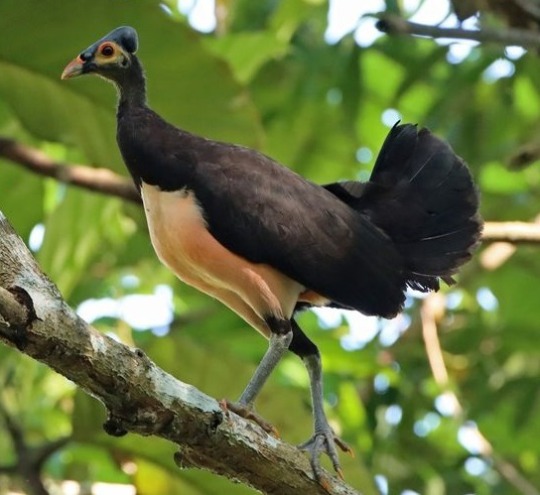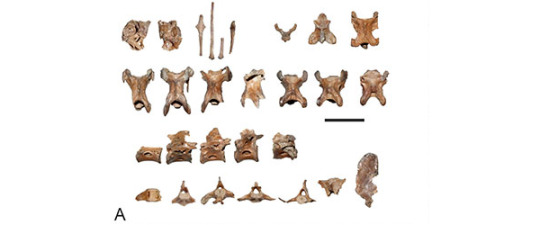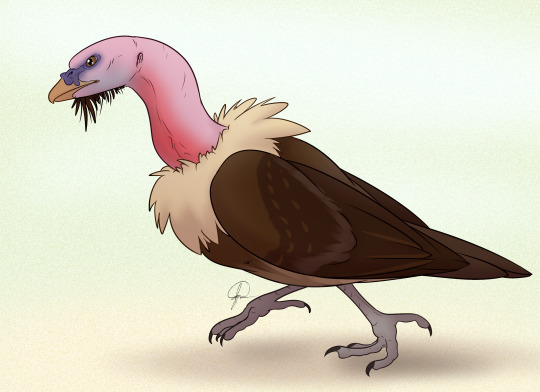#microcephalon
Text

Maleo (Microcephalon maleo), family Megapodiidae, endemic to Sulawesi, Indonesia
CRITICALLY ENDANGERED.
photograph by Luke Seitz
302 notes
·
View notes
Text
Perplexicervix paucituberculata Mayr et al., 2023 (new species)

(Type specimen of Perplexicervix paucituberculata [scale bar = 10 mm], from Mayr et al., 2023)
Meaning of name: paucituberculata = little tuberculate [in Latin]
Age: Eocene (Ypresian), 54.6‒55 million years ago
Where found: London Clay Formation, Essex, U.K.
How much is known: Partial skeleton including vertebrae and fragments of the skull. Partial skeletons of two other individuals may also belong to this species.
Notes: P. paucituberculata was an unusual bird that had small bumps covering its neck vertebrae. This feature is shared with the only other species of Perplexicervix that had been previously named, P. microcephalon, as well as with Dynamopterus tuberculatus (a possible close relative to modern seriemas), both of which are from the Eocene of Germany. In fact, the neck vertebrae of P. microcephalon are even more extensively coated in these bumps than those of P. paucituberculata. Similar structures have not been observed in extant birds and their function is unknown. When they were first noticed in fossil birds, it was thought that they may have been the result of an ancient disease that no longer affects birds today. However, the fact that all known specimens of Perplexicervix preserving neck vertebrae have these bumps suggests that they were instead a typical part of their anatomy.
What type of extant bird Perplexicervix was most closely related to is also unclear. Similarities to waterfowl (specifically screamers) had been noted in earlier studies, and the type specimen of P. paucituberculata had been briefly mentioned in a previous paper as an early waterfowl. New specimens, however, indicate that Perplexicervix did not have the characteristic lower jaw anatomy shared by both waterfowl and landfowl. The describers of P. paucituberculata instead note that some of its bones bear noticeable resemblance to those of bustards, a group of often large, ground-dwelling birds that live in Afro-Eurasia and Australasia today. A close relationship with bustards would be very noteworthy if upheld by future research, given that early members of the bustard lineage are otherwise unknown from the Paleogene Period.
Reference: Mayr, G., V. Carrió, and A.C. Kitchener. 2023. On the "screamer-like" birds from the British London Clay: an archaic anseriform-galliform mosaic and a non-galloanserine "barb-necked" species of Perplexicervix. Palaeontologia Electronica 26: 33. doi: 10.26879/1301
#Palaeoblr#Birblr#Dinosaurs#Birds#Perplexicervix paucituberculata#Eocene#Europe#Neoaves#2023#Extinct
37 notes
·
View notes
Text
Perplexicervix microcephalon

By José Carlos Cortés on @quetzalcuetzpalin
PLEASE SUPPORT US ON PATREON. EACH and EVERY DONATION helps to keep this blog running! Any amount, even ONE DOLLAR is APPRECIATED! IF YOU ENJOY THIS CONTENT, please CONSIDER DONATING!
Name: Perplexicervix microcephalon
Status: Extinct
First Described: 2010
Described By: Mayr
Classification: Dinosauria, Saurischia, Eusaurischia, Theropoda, Neotheropoda, Averostra, Tetanurae, Orionides, Avetheropoda, Coelurosauria, Tyrannoraptora, Maniraptoriformes, Maniraptora, Pennaraptora, Paraves, Eumaniraptora, Averaptora, Avialae, Euavialae, Avebrevicauda, Pygostylia, Ornithothoraces, Euornithes, Ornithuromorpha, Ornithurae, Neornithes, Neognathae
Perplexicervix is a relatively-recently described species of dinosaurs from the Messel Pit of Germany, living about 48 million years ago, in the Ypresian age of the Eocene of the Paleogene. A mysterious bird, it is known from a halfway decent skeleton, and yet it cannot really be assigned a family group further than Neognathae - the group that includes all birds that aren’t Palaeognaths. It could be any sort of bird from this group - ducks, chickens, turacos, hummingbirds, flamingos, parrots, you have it. Granted, it really doesn’t look like any of those, so it also could be a very unique member of the Neognathae group. This dinosaur is known from a whole skeleton on the slab, that has a small skull with a short triangular beak that is a little bit hooked on the end, poors in its head, long and slender wing bones, and long toe bones. These give it a lot of similar characteristics to chickens, screamers, and pigeons, but not entirely similar. It’s shoulders are also robust and rounded, which contrasts with its general long and slender appearance. It is about half the size of Idiornis, the stem-seriema, and is very different in proportion compared to Idiornis, with longer arm bones and shorter finger bones, and the shorter shoulder. It most greatly resembles, in the end, screamers and vultures, but identification beyond that is impossible without more knowledge of its bones. Its ecology may have been predatory, like Idiornis, or something else altogether, due to its different proportions and body type.
Buy the author a coffee: http://ko-fi.com/kulindadromeus
Source:
Mayr, G. 2010. A New Avian Species with Tubercle-bearing Cervical Vertebrae from the Middle Eocene of Messel (Germany). Records of the Australian Museum 62: 21 - 28.
#perplexicervix#perplexicervix microcephalon#bird#dinosaur#birblr#palaeoblr#dinosaurs#paleontology#prehistory#prehistoric life#biology#a dinosaur a day#a-dinosaur-a-day#dinosaur of the day#dinosaur-of-the-day#science#nature#factfile#Dìneasar#דינוזאור#डायनासोर#ديناصور#dínosaurio#risaeðla#ڈایناسور#deinosor#恐龍恐龙#динозавр#dinosaurio
53 notes
·
View notes